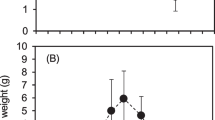Abstract
The aim of this, the third part of our study, was to compare the quantities of food consumed and assimilated by Venus verrucosa L. fed on two different living suspensions: the bacterium Lactobacillus sp. and the alga Pavlova lutheri. The experimental results have been presented in parts I and II of our study. The present paper describes a model constructed for each series of experiments with bacteria and with phytoplankton. An analog-computer model was succesfully applied and revealed that bacterial food was more easily consumed and assimilated than algal food, the dissolved form more easily assimilated than the living particulate form.
Similar content being viewed by others
Literature cited
Allen, J. A. (1962). Preliminary experiments on the feeding and excretion of bivalves using Phaeodactylum labelled with 32P J. mar. biol. Ass. U.K. 42: 609–623
Amouroux, J.M. (1982). Utilisation d'une suspension monospécifique d'algues par Venus verrucosa (bivalves) en milieu semi confiné. Malacologia 22: 659–666
Amouroux, J. M. (1984). Preliminary study on the consumption of dissolved organic matter (exudates) of bacteria and phytoplankton by the marine bivalve Venus verrucosa. Mar. Biol. 82: 109–112
Amouroux, J. M. (1986a). Comparative study of the carbon cycle in Venus verrucosa fed on bacteria and phytoplankton. I. Consumption of bacteria (Lactobacillus sp.). Mar. Biol. 90: 237–241
Amouroux, J. M. (1986b). Comparative study of the carbon cycle in Venus verrucosa fed on bacteria and phytoplankton. II. Consumption of phytoplankton (Pavlova lutheri). Mar. Biol. 92: 349–354
Conover, R. J., Francis, V. (1973). The use of radioactive isotopes to measure the transfer of materials in aquatic food chains. Mar. Biol. 18: 272–283
Foster-Smith, R. L. (1975). The effect of concentration of suspension of filtration rates and pseudofaecal production for Mytilus edulis L., Cerastoderma edule (L.) and Venerupis pullastra (Montagu). J. exp. mar. Biol. Ecol. 17: 1–22
Goldstein, R. A., Elwood, J. W. (1971). A two compartment, three parameter model for the absorption and retention of ingested elements by animals. Ecology 52: 935–939
Grégoire, F. (1972). Pharmacocinétique et analyse compartimentale. J. Pharm. Belg. 27: 98–111
Jensen, L. M. (1983). Phytoplankton release of extracellular organic carbon, molecular weight composition, and bacterial assimilation. Mar. Ecol. Prog. Ser. 11: 39–48
Mague, T. H., Friberg, E., Hughes, J. D., Morris, I. (1980). Extracellular release of carbon by marine phytoplankton: a physiological approach. Limnol. Oceanogr. 25: 262–270
Smith, D. F., Horner, S. M. J. (1981). Tracer kinetic analysis applied to problems in marine biology. Can. Bull. Fish. aquat. Sciences 210: 113–129
Taylor, G. T., Iturriaga, R., Sullivan, C. W. (1985). Interactions of bactivorous grazers and heterotrophic bacteria with dissolved organic matter. Mar. Ecol. Prog. Ser. 23: 129–161
Tenore, K. R., Dunstan, W. M. (1973). Comparison of feeding and biodeposition of three bivalves at different food levels. Mar. Biol. 21: 190–195
Thingstad, T. F., Pengerud, B. (1985). Fate and effect of allochthonous organic material in aquatic microbial ecosystems. An analysis based on chemostat theory. Mar. Ecol. Prog. Ser. 21: 47–62
Thompson, R. J., Bayne, B. L. (1972). Active metabolism associated with feeding in the mussel Mytilus edulis L. J. exp. mar. Biol. Ecol. 9: 111–124
Vietinghoff, U. (1984). Mathematical modelling of the ecosystem Barther Bodden. Limnologica, Berlin 15: 253–262
Widdows, J., Bayne, B. L. (1971). Temperature acclimation of Mytilus edulis with reference to its energy budget. J. mar. biol. Ass. U.K. 51: 827–843
Winter, J. E. (1969). Über den Einfluß der Nahrungskonzentration und anderer Faktoren auf Filtrierleistung und Nahrungsausnutzung der Muscheln Arctica islandica und Modiolus modiolus. Mar. Biol. 4: 87–135
Winter, J. E. (1978). A review on the knowledge of suspension-feeding in lamellibranchiate bivalves, with special reference to artificial aquaculture systems. Aquaculture, Amsterdam 13: 1–33
Wright, R. T., Coffin, R. B., Ersing, C. P. (1982). Field and laboratory measurements of bivalve filtration of natural marine bacterioplankton. Limnol. Oceanogr. 27: 91–98
Author information
Authors and Affiliations
Additional information
Communicated by J. M. Pérès, Marseille
Rights and permissions
About this article
Cite this article
Amouroux, J., Amouroux, J. Comparative study of the carbon cycle in Venus verrucosa fed on bacteria and phytoplankton. Mar. Biol. 97, 339–347 (1988). https://doi.org/10.1007/BF00397764
Accepted:
Issue Date:
DOI: https://doi.org/10.1007/BF00397764




